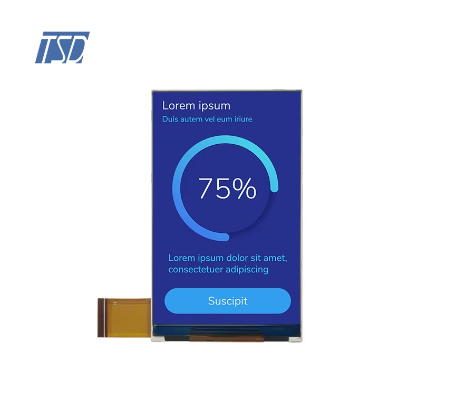Understanding LCD Display Module Components
Monochrome vs. Color TFT Display Types
Monochrome and color TFT displays serve distinct functions and cater to different Application areas. Monochrome displays primarily offer simplicity and efficiency, making them ideal for devices that prioritize low power consumption and cost-effectiveness, such as calculators and parking meters. In contrast, color TFT displays provide vibrant imagery and visual dynamism, appealing to applications where aesthetics and user experience are crucial, such as smartphones and car infotainment systems. The adoption of color displays is driven by the need for enhanced user interaction and visual appeal, with industry insights highlighting their growing preference in consumer electronics and advertising sectors.
Core Elements: Glass Panel, PCB, and Backlight
The fundamental components of an LCD display module include the glass panel, PCB, and backlight. The glass panel, usually constructed from materials like gorilla glass or other durable composites, plays a key role in ensuring display clarity and protection against physical damage. The PCB, or printed circuit board, serves as the brain of the display, handling signal processing and ensuring the seamless functioning of the module. Backlighting options, such as LED and EL (electroluminescent), are vital for adjusting brightness and power efficiency. LED backlights are favored for their energy efficiency and high brightness, while EL backlights can offer uniform light distribution.
Touch Panel Integration Options
Touch panel integration into LCD displays can be achieved through technologies like capacitive and resistive touch panels. Capacitive panels are known for their high sensitivity and multi-touch capabilities, ideal for consumer electronics like smartphones. However, they can be more expensive and less responsive to non-conductive inputs like gloves. Resistive panels, although generally less sensitive, are more affordable and can function in various environmental conditions, making them suitable for industrial applications. Successful integration of touch technology requires addressing challenges such as calibration and ensuring robustness against environmental factors, emphasizing the need for strategic design choices in custom projects.
Planning Your Custom LCD Display Project
Defining Requirements: Size, Resolution, and Interface
The initial step in planning your custom LCD display project is to define the requirements for size, resolution, and interface. The size of the display is often dictated by the application context—whether it's for a handheld device or a large industrial panel. Resolution greatly impacts display quality; higher resolutions result in clearer images, which enhances the user experience. Data shows that screens with higher pixel density improve user satisfaction and reduce eye strain. For interface options, common choices include SPI (Serial Peripheral Interface), I2C (Inter-Integrated Circuit), and parallel interfaces. Each has its pros and cons: SPI is ideal for small distances and lower power, I2C is great for multiple devices on the same bus, and parallel interfaces offer high data transfer speeds but require more pins.
Semi-Custom vs. Fully Custom Design Approach
Understanding the differences between semi-custom and fully custom design approaches is crucial for LCD projects. Semi-custom designs modify existing standard Products to fit specific applications, while fully custom designs start from scratch, tailoring each component. Industry practices typically favor semi-custom solutions due to lower costs and shorter timelines; for example, color TFTs often rely on semi-custom modifications to keep tooling costs down. Fully custom designs, while costlier and time-intensive, offer more design freedom and are preferable when unique specifications are needed, as seen in high-end applications like new smartphone screens. The choice between these approaches depends on client needs, available budget, and project goals.
Budgeting for Tooling and Component Costs
Effective budgeting for tooling and component costs is essential for custom LCD projects. Typical tooling costs include custom monochrome displays at $4,500–$6,500 and custom color TFT displays at $70,000–$200,000. To save on costs, consider bulk purchasing or using alternative materials. Additionally, allocating resources for unexpected expenses is vital in the budgeting process, ensuring project flexibility and sustainability. Adopting a cost-efficient strategy, such as choosing a semi-custom approach where applicable, can substantially reduce initial outlay and streamline production.
Essential Tools and Materials for DIY Assembly
Soldering Equipment and Precision Tools
To successfully assemble a custom LCD display module, having the right soldering equipment is crucial. Essential tools include a quality soldering iron, solder wire, and a desoldering pump, each serving distinct purposes like bonding components or removing unwanted solder. Precision tools like tweezers and magnifying lamps are equally important for accurately placing and connecting delicate components. Safety is paramount; always work in a well-ventilated space, use protective eyewear, and keep a fire extinguisher nearby to handle any soldering-related hazards.
Compatible Microcontrollers/Drivers
Choosing the right microcontroller is vital for the seamless operation of your custom LCD display. Popular options include the Arduino, Raspberry Pi, and ESP32, each offering different compatibility and performance features. For optimal performance, selecting a compatible driver is essential; a suitable driver ensures that data is efficiently transferred between the microcontroller and the LCD. Common applications range from Home automation systems using Arduino to complex IoT projects powered by ESP32. Each choice impacts the display's responsiveness and functionality.
Mechanical Components: Bezels and Overlays
Bezels and overlays play a dual role in not only protecting LCD screens but also enhancing their visual appeal. Bezels, typically made from durable materials like aluminum or plastic, offer robust protection against environmental elements, while overlays can be crafted from glass or acrylic for additional display safeguarding. The selection of materials should balance durability with cost considerations. Design should integrate bezels and overlays seamlessly, ensuring that they complement the overall aesthetics and functionality of the display module without hindering visibility or operation.
Step-by-Step Custom LCD Assembly Process
PCB Preparation and Driver Configuration
Preparing the PCB is a foundational step in custom LCD assembly, requiring careful cleaning, soldering, and layout verification. First, clean the PCB to remove any debris or residue that could affect soldering effectiveness. Then, solder the components onto the board, ensuring connections are secure and free of shorts. After soldering, verify the layout to ensure all components are correctly placed and connected. For driver configuration, common tools like software utilities specific to your driver can assist in setting the correct parameters. Troubleshooting may involve checking connections or verifying driver settings, as incorrect configurations can lead to functionality issues.
Display Panel Integration Techniques
Integrating the display panel with the PCB requires precise techniques such as alignment and securing methods. Begin by ensuring the panel is perfectly aligned with the PCB to prevent any operational issues. Potential pitfalls during this stage include misalignment, which can lead to connectivity problems. Use proper alignment techniques to mitigate this risk. Adhesive methods, like using conductive adhesives, are crucial in securing connections, ensuring that the panel remains firmly attached without disrupting electrical pathways.
Backlight Installation and Calibration
Proper backlight installation is key to a fully functional custom LCD display. Start by carefully following installation guides to correctly place the backlight within the assembly, avoiding any physical damage to delicate components. Calibration is vital for achieving the desired brightness and color balance, which can be accomplished by adjusting the current settings according to manufacturer recommendations. After installation, verifying the functionality of the backlight ensures that everything is working as expected and that the visual output meets the necessary standards.
Securing the Bezel for Professional Finish
Securing the bezel is crucial for both protecting the display and enhancing its professional appearance. This involves using the right tools and fasteners to attach the bezel firmly without causing any damage. Best practices include aligning the bezel precisely and ensuring a tight fit to avoid gaps. Sealing methods, such as using appropriate adhesives or screws, enhance durability and give the assembly a polished finish. Attention to these details is essential in achieving a display that not only functions well but also looks aesthetically pleasing.
Testing and Troubleshooting Your Module
Diagnosing Common Electrical Issues
Identifying electrical problems in custom LCD modules is crucial for ensuring their optimal functionality. Common issues include faulty connections, improper grounding, and voltage irregularities. To address these, diagnostic techniques such as using a multimeter to check for voltage drops or resistance issues can be employed. Resources like online forums, manuals, and specialist consultancies can offer further guidance on troubleshooting these complexities, aiding in efficient resolution.
Optimizing Viewing Angles and Brightness
Optimizing viewing angles is essential for enhancing user experience with custom LCD modules. By calibrating the screen's orientation, users can access a clear and consistent display from various angles. Adjusting brightness settings is equally important, particularly in adapting to different environmental light conditions. Research shows that well-optimized LCDs result in improved performance and prolonged battery life, underscoring the value of these adjustments.
Stress-Testing for Long-Term Reliability
Conducting stress tests on custom LCD modules helps ensure their reliability over time. This involves simulating environmental conditions and operational loads over extended periods to identify potential stress points. Factors influencing reliability, such as temperature resilience and response rates, can be evaluated through standardized frameworks. Studies in tech journals highlight that consistent stress-testing can significantly extend the lifespan of LCD modules, affirming its importance in the development process.
FAQ
What are the main differences between monochrome and color TFT displays?
Monochrome displays focus on simplicity and low power usage, making them suitable for devices like calculators. Color TFT displays offer vibrant visuals, ideal for enhancing user experience in applications like smartphones.
What components are essential for an LCD display module?
Key components include the glass panel for clarity, the PCB for signal processing, and backlight options like LED for brightness adjustment.
How do touch panels integrate into LCD displays?
Touch panels integrate through capacitive or resistive technologies, with capacitive offering high sensitivity and resistive being more cost-effective.
What factors should be considered when planning a custom LCD display project?
Considerations include size, resolution, interface options, design approach (semi-custom vs. fully custom), and budgeting for tooling and component costs.
Which tools and materials are necessary for DIY LCD assembly?
Essentials include soldering equipment, precision tools, compatible microcontrollers, and mechanical components like bezels and overlays.
What steps are involved in the custom LCD assembly process?
Steps include PCB preparation, display panel integration, backlight installation, and securing the bezel for a professional finish.
How is the reliability of an LCD module tested?
Reliability is tested through stress-testing and diagnosing electrical issues, ensuring long-term performance.
Table of Contents
- Understanding LCD Display Module Components
- Planning Your Custom LCD Display Project
- Essential Tools and Materials for DIY Assembly
- Step-by-Step Custom LCD Assembly Process
- Testing and Troubleshooting Your Module
-
FAQ
- What are the main differences between monochrome and color TFT displays?
- What components are essential for an LCD display module?
- How do touch panels integrate into LCD displays?
- What factors should be considered when planning a custom LCD display project?
- Which tools and materials are necessary for DIY LCD assembly?
- What steps are involved in the custom LCD assembly process?
- How is the reliability of an LCD module tested?




